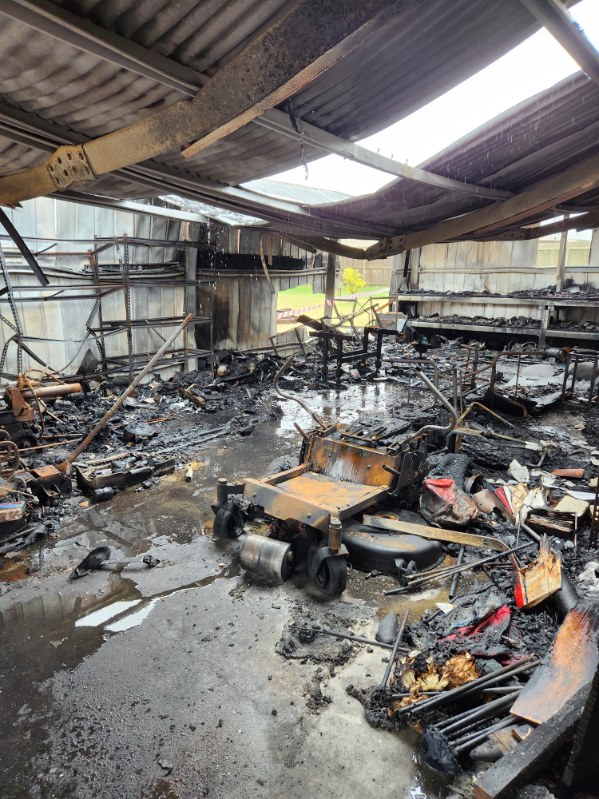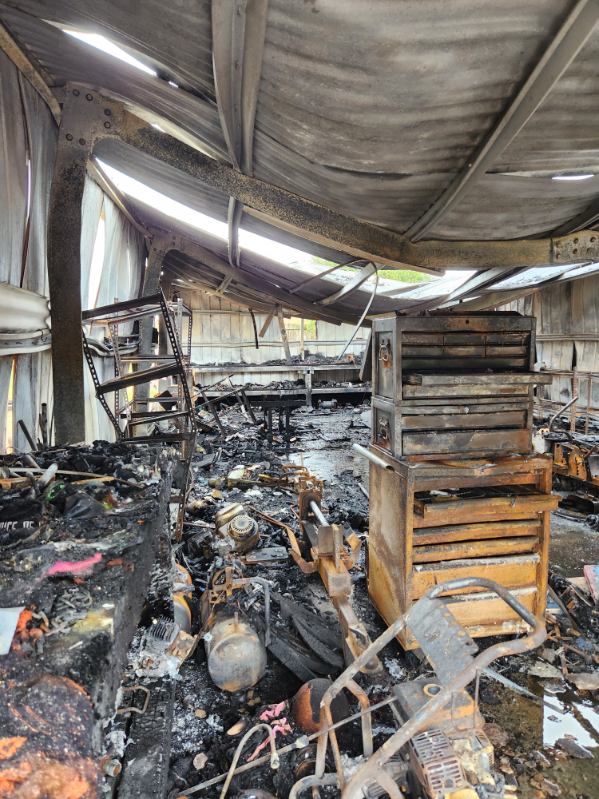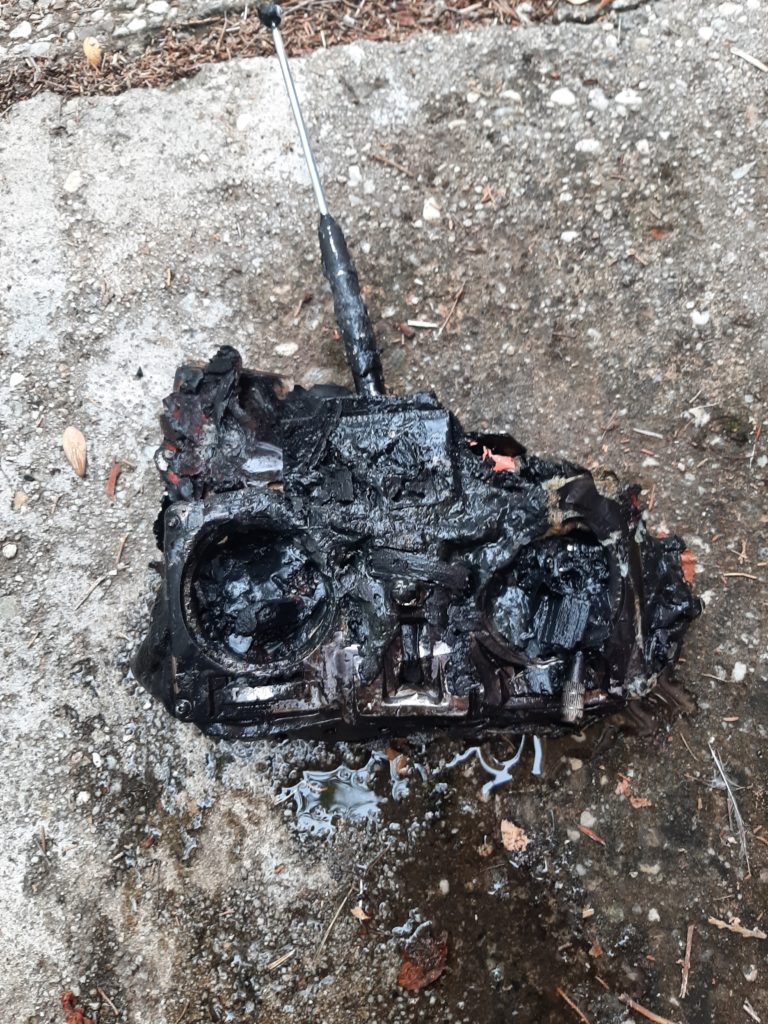
The catalyst for this overall discussion was two LiPo related incidents in home workshops within a couple of months of each other – and at the homes of two colleagues we know and respect. They were a real wake-up call that this can happen to anyone. Thankfully no one was hurt, and they are both willing to share their experience. Both fires started by small 2s LiPo batteries being charged.
These were are first ‘post mortems’ and primary catalyst for our emerging ‘What Can I Do?’ action plan.
Impact of a Battery Fire
In talking to those with first-hand experience of catastrophic fires we can’t help but be struck by the graphic details of what happened, and the very limited ability to do anything about it other than protect themselves. Here are a few themes that really hit us:
- The initial intense heat – described as 800 C flames somewhere between an intense flare and an explosion coming in multiple waves. Uncontained (as they were) this acted as an instant fire starter igniting anything within a couple of metres radius.
- The sheer volume of toxic, hot and blinding smoke engulfing the immediate space and permeating through any available gap. Forget any chance of getting to the batteries or source of power to intervene once the fire has caught – this is an almost instant no go zone. In one case, hands and knees to crawl to safety out of workshop and garage space was the only option.
- That is just the direct impact. The secondary impact of the spreading fire in a workshop or garage is equally dangerous. Butane gas containers, spray paint cans, thinners, fuels, other exposed batteries all become sources of explosions or other incendiary events catalysed by the initial source. Extremely dangerous.
- And with LiPo batteries we are dealing with an anaerobic reaction – it doesn’t need oxygen to burn. Fire fighters, clad in full protective gear to get near them, douse them in sand or submerge them in water to control collateral damage while the fire burns its course.
- If the direct and secondary fire damage are not bad enough, the sticky smoke gets absolutely everywhere creating a massive clean-up exercise on anything that isn’t directly destroyed.
Photos of the aftermath are devastating, as are the stories from those involved.
The opening photo is from a fire in Bairnsdale that destroyed a complete workshop, which was thankfully isolated from the house. The headline photo in this section was taken soon after it started and before the fire brigade arrived. Tools, three lawn mowers, a classic car and multiple models all gone. Photos of the aftermath below.


The Albury fire happened at 10:30pm and consumed an entire garage and workshop directly under a house.
The owner reiterates that almost all of those he spoke to while replacing his many models and other workshop contents mentioned that they have been hearing of multiple similar situations. And the fire brigade captain said they were attending a battery fire 3 to 4 times a week.



And 2 more photos from the Albury fire. The hole in the garage door was shrapnel from an exploding butane gas canister from a workshop blow torch. The other picture is of the smoke damage in the kitchen above the workshop.


Anatomy of a LiPo Fire
Putting together these observations with some of the explanations of the anatomy of a LiPo event, we are dealing with a cascading and rapidly evolving environment that is highly unstable. This seems to be broadly described as thermal runaway.
- Most likely the event will start with a failure in a single cell within a battery – described as an initial ‘pop’ or similar, followed by some smoke and possible flames developing (this can be immediate, or evolve over minutes depending on the cause and intensity of the failure).
- While the initial cell fails in this way, it will heat any surrounding cells and trigger an equal reaction in them – with the rate of progression dependent on intensity of the initial fire. So a potential secondary, unpredictable wave of ‘ignitions’ as a delayed chain reaction works through the battery
- This is an anaerobic fire – it does not need oxygen to propagate, and the battery cells themselves will keep burning until the energy stored in them is exhausted. The general view is that it is the polymer and other plastics in the batteries that, when taken above their ignition temperatures, create the intense, toxic and corrosive smoke.
- For an uncontained fire, cascading risk continues to the immediate environment as a mix of explosions and ‘flares. What is within immediate range – other batteries just charged or waiting, the charging bench itself, models, aerosol paint cans? The list continues. We now have the core battery fire acting as a catalyst to whatever secondary tertiary fires can be created.
A clear picture emerges. The risk is of a highly unstable chain reaction, a cascading ‘fire’ triggered by intense temperatures that spreads to everything in sight and is highly dangerous to all involved.
Implications and Options
Understanding the anatomy of a LiPo fire and potential escalation helps a little in thinking through what we can do. Put simply we are looking for solutions that:
- Prevent the fire in the first place – understanding the risks and following best practice.
- Contain the initial ignition flare / explosion and subsequent battery fire.
- Manage the smoke away from confined spaces; and
- Prevent the chain reaction that implicates / engulfs everything in its wake.
There is no easy or direct mapping of actions to each of these themes, but there are clear thought starters aligned with our emerging ”What Can I do?” action plan linked below.